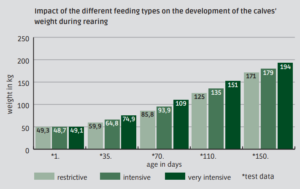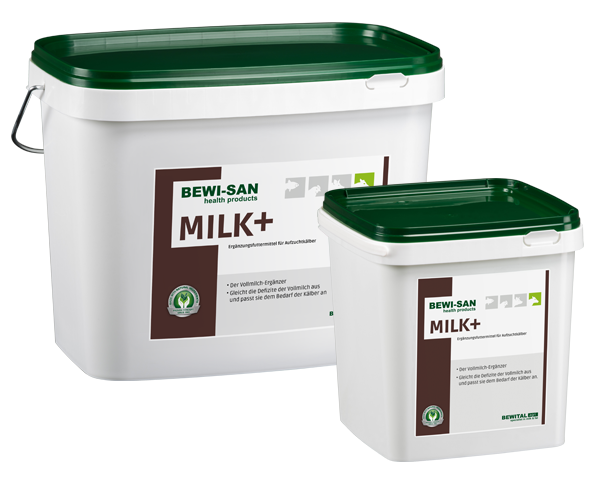Intensive calf feeding is cost-effective despite higher prices
Economically successful dairy farms attach importance to both high milk yields and a long productive life time of dairy cattle. The foundation for achieving these goals has to be laid during calf rearing.
Due to the rising prices for calf milk, several farm managers are playing with the idea of using whole milk instead of milk replacer during calf rearing. However, this does not make sense from a health and economic point of view!
Intensive calf feeding pays off later!
Scientific studies clearly show the influence of the first months of life and especially of the drinking phase on the performance and productive life of later dairy cows.
Bothe et. al investigated the influences of different intensities in calf rearing (restrictive, intensive and very intensive) during the ten-week drinking period on the later milk yield of the animals. For this purpose, three feeding tests with 250 female calves were carried out at Haus Riswick between 2009 and 2013 over a period of 150 days.
The calf milk replacers (CMR) used in the tests contained 40% skimmed milk powder and 18, 22 or 23% crude protein. Weaning was linear from six to zero litres in 28 days.

Results: Live weight and daily weight gain of the calves
The calves’ weight developed very different in the three groups during calf rearing. The very intensively reared calves weighed on average 109 kg after the feeding period, the intensively reared calves 93.9 kg and the restrictively reared calves 85.8 kg. The development of daily gains was thus consistent. The very intensively reared calves gained 943 g daily and the restrictively raised calves only 602 g.

Results: Milk yield of the cows during the first lactation
The intensively raised calves had a higher milk yield during their first lactation than the calves that were fed restrictively. By giving 12-15 kg more milk replacer during intensive calf rearing, the milk yield could be increased by more than 1000 kg. The additional costs for the milk replacer are therefore no longer significant due to the increased milk yield.
The very intensively fed calves did not differ from the other two groups. Their milk yield was not higher.

Conclusion: Intensity improves performance!
- It is recommended to provide calves with at least 45 kg milk replacer during the milk phase.
- The calves’ higher daily weight gain and live weight helps them to overcome stress (e.g. changing stables) more easily and exploit their full growth potential.
- Intensive rearing with BEWI-MILK® milk replacers during the calf’s first weeks of life leads to an increased milk yield in the first lactation.
If whole milk, then with complement!
When feeding calves on dairy farms with whole milk there is always a risk. Compared to the calf’s nutritional demand, whole milk contains less trace elements (especially iron!).
Iron is not only an essential component for the formation of the blood element haemoglobin, but is also producing antibodies which fight against infections. Anaemia, lower daily weight gains and a week immune system are among the most significant consequences of iron deficiency.
The current recommendation is up to 100 mg iron per animal per day and is ensured by application of milk replacer.
Complement of whole milk makes sense
When feeding whole milk essential vitamins, minerals and trace elements are insufficient. The immune forces are weakened.
BEWI-SAN Milk+ wipes out this failure and promotes a healthy development of the calf.
